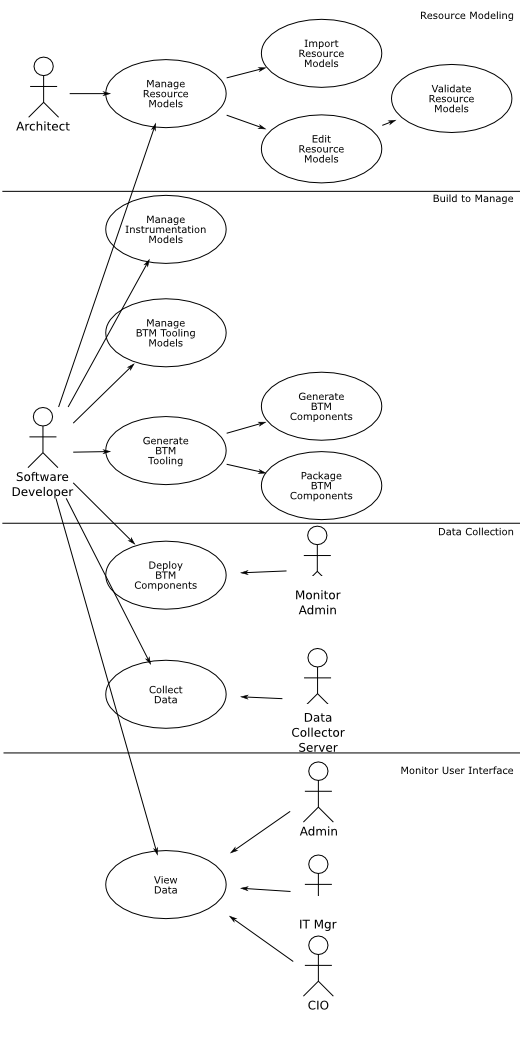Notice: this Wiki will be going read only early in 2024 and edits will no longer be possible. Please see: https://gitlab.eclipse.org/eclipsefdn/helpdesk/-/wikis/Wiki-shutdown-plan for the plan.
Difference between revisions of "End-to-End use cases"
(→SML and Use Cases) |
|||
| Line 1: | Line 1: | ||
| + | {{Edit Note|text=This article is a work in progress. I'm hard at work making edits from the working session held Dec 4, 2006.}} | ||
| + | |||
This article presents the "end-to-end" use cases for Eclipse COSMOS. This work is an attempt to collect all of the key use cases under one roof, primarily for purposes of identifying scope and release phases. This high-level view of use cases also supports analysis of the opportunities for extensions built on the Eclipse COSMOS framework by commercial and open source communities. | This article presents the "end-to-end" use cases for Eclipse COSMOS. This work is an attempt to collect all of the key use cases under one roof, primarily for purposes of identifying scope and release phases. This high-level view of use cases also supports analysis of the opportunities for extensions built on the Eclipse COSMOS framework by commercial and open source communities. | ||
Revision as of 12:44, 5 December 2006

|
This article is a work in progress. I'm hard at work making edits from the working session held Dec 4, 2006. |
This article presents the "end-to-end" use cases for Eclipse COSMOS. This work is an attempt to collect all of the key use cases under one roof, primarily for purposes of identifying scope and release phases. This high-level view of use cases also supports analysis of the opportunities for extensions built on the Eclipse COSMOS framework by commercial and open source communities.
Work on fleshing out these use cases continues, in the context of workgroups.
- The first meeting was October 31, 2006 2-3pm EST. See the minutes for more information.
- Another meeting was held on this subject on December 4, 2006, 1:30-5pm PST. See the minutes.
Contents
Actors and Use Cases
The diagram sketches out the end-to-end use cases. Time progresses vertically, down the diagram. Note that the Software Developer actor participates in all of the use cases. This is in recognition of the development-time tasks that Eclipse COSMOS supports. Note, also, that the production-time tasks of the Data Collection and Monitor User Interface use cases depict their actors in a swimlane to the left.
Resource Modeling Use Cases
In these use cases, the Software Architect manages Resource Models. A Resource Model could be created from scratch using a model editing framework. Or, a Resource Model could be imported, either from a local model repository, from a supplier's repository (a set of Resource Models from a hardware manufacturer, or a software vendor), or perhaps it could be provided from a discovery monitor (hey, I found one of these resources at ip address 172.28.111.123).
Build to Manage Use Cases
Here, the Software Developer creates an Instrumentation Model for a Resource Model. This is either a related SML model or an extension or decoration of the Resource Model itself. The Instrumentation Model describes the measurements that are available, relevent, or required for the elements of the Resource Model.
Next the Software Developer manages the Build to Manage Tooling Model for an Instrumented Resource Model. This, again, is either a related SML model or an extension or decoration of the Resource Model. The BTM Tooling Model describes how the Instrumented Resource Model's requirements will be fulfilled with generated tooling componentry.
Finally, the Software Developer generates the BTM components and packages them for deployment.
Data Collection Use Cases
In these use cases the BTM Tooling is installed in the managed environment, and data collection is performed.
Monitor User Interface Use Cases
In these use cases, the collected data is retrieved for use in visualization.
SML and Use Cases
Simplified Model
The Eclipse COSMOS project has 2 early release milestones, 0.5 (planned for March 2007) and 1.0 (planned for June 2007). The relationship between Eclipse COSMOS and the SML standard presents some risk to these dates -- because SML is still evolving during its public review process, it is likely that there will be some adverse effect on early software developed that depends on the standard.
One approach to manage this risk is to simplify the system that we model with SML; and further, to simplify the extent of the modeling required for this simple system.
Here is a quick sketch of the system we plan to be able to model with SML in Eclipse COSMOS at its release 1.0:
The green boxes indicate the type of tooling we could use to observe the properties of the resource.
In order to manage the near-term risk from changes to SML, we propose to simplify this system to this model:
The green boxes indicate the type of tooling we could use to observe the properties of the resource.
In the very-simple-model, each of the host, app server, and application have one property that we will observe, operationalStatus.
SML and ME
The Management Enablement use case is implemented by reading the SML model for the system. In our simplistic use case, there are two types of tooling needed, WSDM for the host, and JMX for the application and the app server.



